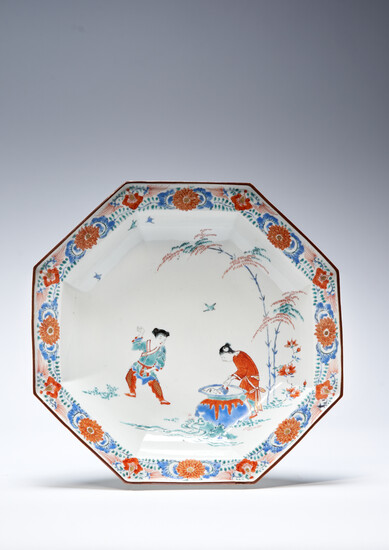A LARGE JAPANESE KAKIEMON 'HOB IN THE WELL' DISH
A LARGE JAPANESE KAKIEMON 'HOB IN THE WELL' DISH
EDO PERIOD, C.1680
The deep octagonal body painted to the well with the legend of Shiba Onko, the small boy being rescued from the large jar whilst another boy looks on, with four small birds flying over them and flowering sprays of peonies and bamboo by their side, all within a band of chrysanthemum and camellia flowerheads amongst scrolling tendrils, the decoration rendered in polychrome enamels and with details highlighted in gold; the rim with a brown iron-oxide glaze, the underside left undecorated and with three spur marks, 24.1cm.
Provenance: formerly a private German collection.
See O Impey, Japanese Export Porcelain, Catalogue of the Collection of the Ashmolean Museum, Oxford, p.157, nos. 229 and 230, for two other examples of Japanese 'Hob in the well' dishes in the museum collections. Also, see the Rijksmuseum, access. no. BK-1968-233-A for another good example.
This scene was one of the most popular Japanese Kakiemon motifs copied by European factories in the 18th century. The famous Chinese Song Dynasty statesman Sima Guang (or Shiba Onko in Japanese) was renowned for his intelligence. As a child, he rescued a friend by throwing stones at the jar in which he was drowning and smashing it. The design was misunderstood by Europeans who thought the boy was a spirit living in the jar. According to Oliver Impey, the European name for this pattern came from a farce by Colley Cibber entitled 'Flora or Hob-in-the-Well' (1711). In the Netherlands, these dishes were referred to as 'mirror plates' or 'the little man in the well'.
View it on
Estimate
Time, Location
Auction House
A LARGE JAPANESE KAKIEMON 'HOB IN THE WELL' DISH
EDO PERIOD, C.1680
The deep octagonal body painted to the well with the legend of Shiba Onko, the small boy being rescued from the large jar whilst another boy looks on, with four small birds flying over them and flowering sprays of peonies and bamboo by their side, all within a band of chrysanthemum and camellia flowerheads amongst scrolling tendrils, the decoration rendered in polychrome enamels and with details highlighted in gold; the rim with a brown iron-oxide glaze, the underside left undecorated and with three spur marks, 24.1cm.
Provenance: formerly a private German collection.
See O Impey, Japanese Export Porcelain, Catalogue of the Collection of the Ashmolean Museum, Oxford, p.157, nos. 229 and 230, for two other examples of Japanese 'Hob in the well' dishes in the museum collections. Also, see the Rijksmuseum, access. no. BK-1968-233-A for another good example.
This scene was one of the most popular Japanese Kakiemon motifs copied by European factories in the 18th century. The famous Chinese Song Dynasty statesman Sima Guang (or Shiba Onko in Japanese) was renowned for his intelligence. As a child, he rescued a friend by throwing stones at the jar in which he was drowning and smashing it. The design was misunderstood by Europeans who thought the boy was a spirit living in the jar. According to Oliver Impey, the European name for this pattern came from a farce by Colley Cibber entitled 'Flora or Hob-in-the-Well' (1711). In the Netherlands, these dishes were referred to as 'mirror plates' or 'the little man in the well'.



